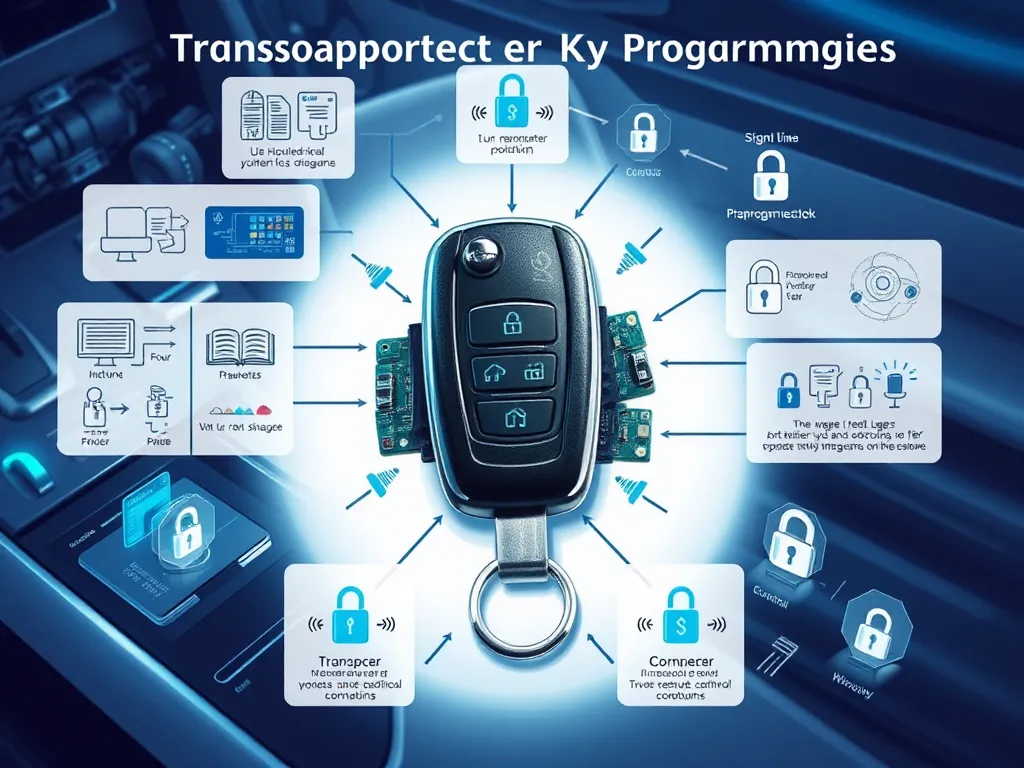Understanding Transponder Key Programming: A Complete Guide

Transponder Key Programming: A Comprehensive Guide
Transponder Key Programming is a crucial aspect of modern vehicle security systems. This technology involves the synchronization of a vehicle's ignition system with a special key that contains an embedded microchip. Without proper programming, a transponder key will fail to start the engine, rendering the vehicle immobilized. In this article, we will explore the intricacies of transponder key programming and its significance in protecting vehicles from theft.
When evaluating your options, consider the average cost of services to ensure you choose the best value for your money.
The primary function of transponder keys is to enhance automotive security by ensuring that only authorized keys can start the vehicle. Transponder keys work by emitting a unique code to the vehicle's ignition system when inserted. If the code matches the one programmed into the car's computer, the engine will start; otherwise, it remains inoperable. This security measure is a significant advancement over traditional mechanical keys.
Transponder Key Programming involves a combination of electronic and mechanical processes. The technology relies on radio frequency identification (RFID), where the key's microchip transmits a signal to the car's receiver. The programming process can be performed through dealer services, locksmiths equipped with specialized tools, or do-it-yourself methods, depending on the vehicle's make and model.
Knowing how to program a transponder key is essential for vehicle owners, especially in case of lost or damaged keys. It not only helps in obtaining a replacement key but also allows the owner to add additional keys for convenience. Understanding the programming process and its implications can save time and costs associated with locksmith services or dealer visits.
Understanding the factors that influence rekey cost can help you make informed decisions about your security needs.
In summary, Transponder Key Programming is a vital component of automotive security that ensures only authorized keys can start a vehicle. Familiarity with this programming process is beneficial for vehicle owners, leading to increased convenience and enhanced vehicle security.
What is Transponder Key Programming?
Transponder Key Programming refers to the process of encoding a transponder key to communicate with a vehicle's ignition system. Each transponder key contains a unique microchip that sends a specific signal when the key is inserted into the ignition slot. This signal is essential for the vehicle to recognize the key as a permitted one, enabling the engine to start.
Transponder keys work by utilizing a unique code embedded within the microchip. Upon insertion of the key, the ignition system sends a request for identification. The microchip responds with its unique code. If this code matches the one stored in the vehicle's on-board computer, the engine is allowed to start; if not, the vehicle remains immobilized, thus preventing theft.
Homeowners should be aware of the average cost of rekeying to budget for necessary security measures effectively.
The technology behind transponder keys capitalizes on RFID systems, which enable secure identification through radio waves. Each transponder key has a specific unique identification number programmed at the factory or during a subsequent programming session. The interaction between the key and the vehicle's computer operates under strict encryption protocols to ensure maximum security against unauthorized access.
Importance of Transponder Key Programming
Programming your transponder key is essential for multiple reasons. Firstly, it ensures that you always have access to your vehicle, especially in situations where original keys are lost or damaged. Secondly, it allows you to have spare keys made for family members or trusted individuals without the need for additional dealer services. Lastly, properly programmed transponder keys contribute to overall vehicle security, thwarting potential theft attempts.
An unprogrammed transponder key can lead to significant inconvenience, as it will not start the vehicle. This may result in being stranded or incurring extra expenses for towing or locksmith services. In severe cases, not having a programmed key could require a complete reprogramming of the vehicle's ignition system, which can be both time-consuming and costly.
Properly programmed transponder keys enhance vehicle security by ensuring that only recognized keys can start the engine. This effectively deters thieves who might attempt to use duplicate or unauthorized keys. By maintaining key programming, vehicle owners can have peace of mind knowing their vehicle is better protected against theft and unauthorized access.
Types of Transponder Key Programming
There are various types of transponder keys, including blade keys, remote head keys, and smart keys. Blade keys resemble traditional keys but contain a transponder chip. Remote head keys combine a regular key with a remote control for keyless entry, while smart keys operate without physical insertion into the ignition and typically use push-button start technology.
When comparing factory and aftermarket transponder keys, factory keys are produced by the vehicle manufacturer and tend to have more reliable programming functions. Aftermarket keys can be less expensive but may not always provide the same level of compatibility or security, as they could vary in quality and performance regarding transponder signal transmission.
Methods of transponder key programming can be categorized into three primary techniques: dealer programming, locksmith programming, and DIY programming. Dealer programming is conducted by dealerships using specialized equipment. Locksmith programming is performed by licensed automotive locksmiths who possess advanced tools for coding keys, while DIY programming often relies on user manuals and online guides, although this method may not be compatible with all vehicle models.
Transponder Key Programming Process
Programming a transponder key usually involves a step-by-step process: First, ensure you have at least one working key or be prepared for a more complex programming process. Next, insert the key into the ignition and turn it to the 'On' position without starting the engine. After that, follow the specific programming instructions for your vehicle model, which may include a sequence of key turns or button presses. Finally, test the newly programmed key to ensure proper functionality.
Essential tools for transponder key programming include a working transponder key, the new key to be programmed, an automotive scanner or programming tool, and access to your vehicle's user manual for reference. Some advanced locksmiths also utilize specialized software for programming transponder keys more efficiently in various makes and models.
Common mistakes to avoid during programming include not following the procedure accurately, using non-compatible keys, and failing to program supplementary keys with the existing ones. It's essential to ensure all keys are programmed within the same session to prevent any interferences or recognition issues with the vehicle's computer.
Troubleshooting Transponder Key Issues
Identifying common transponder key programming problems involves recognizing symptoms like the engine not starting, dashboard warning lights, or a message indicating that the key is not recognized. Other issues may include problems with key battery life that prevent communication with the ignition system.
Solutions for key recognition issues typically include checking the battery in the key, ensuring that the key is clean and undamaged, and verifying the programming procedure was followed correctly. In some instances, reprogramming the key may resolve recognition problems. Additionally, ensuring that the vehicle's ignition is in optimal condition can aid in solving key-related issues.
When to seek professional help for programming errors is critical to consider. If the key remains unrecognized despite troubleshooting efforts or if multiple keys fail to operate correctly, it's advisable to consult a certified locksmith or dealership for assistance. They have the expertise and equipment to diagnose and rectify complex issues that may arise during transponder key programming.
